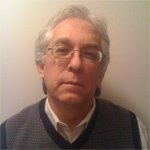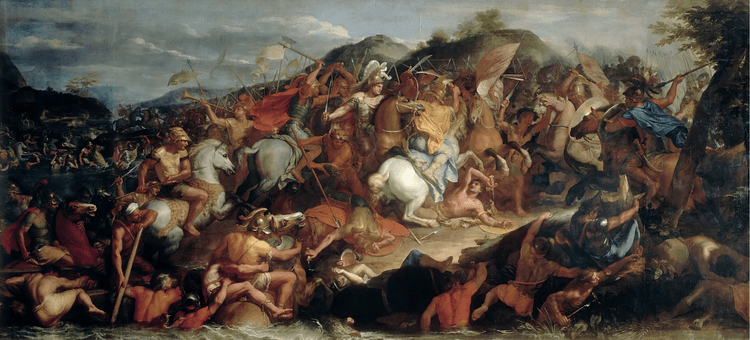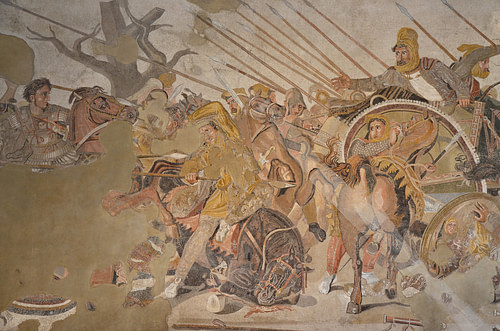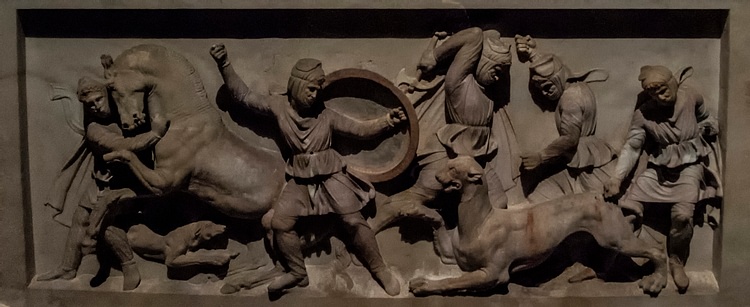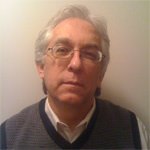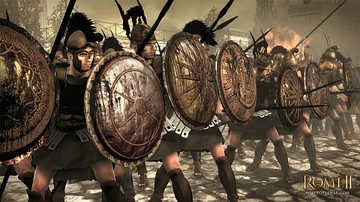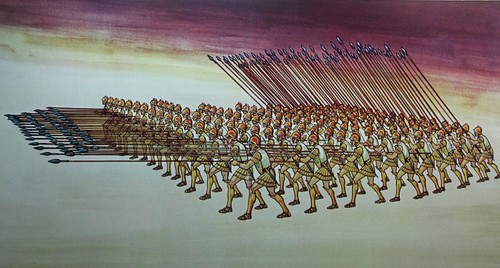
The Pezhetairoi (foot companions) were part of the imposing army that accompanied the Macedonian commander Alexander the Great (r. 336-323 BCE) when he crossed the Hellespont to face the Persian king Darius III in 334 BCE. Armed with long pikes (sarissas), the pezhetairoi fought in a Greek phalanx formation and played an important role in the battles of the Granicus, Issus, and Gaugamela.
Origin
Like with the hypaspist, the origin and evolution of the pezhetairos (plural: pezhetairoi) are shrouded in mystery. Except for references to them in discussions of Philip II and Alexander, the term pezhetairoi is hardly found in ancient literature. In his The Army of Alexander the Great, historian Stephen English wrote that, at some inexact point, the peasantry was recruited territorially and organized into infantry, and, according to the historian Anaximenes, it was given the name pezhetairoi. He added that the pezhetairoi were "essentially an evolution of the standard phalanx" (3).
However, disagreements still persist: some scholars refer to all of the Macedonian infantry as pezhetairoi while others believe they were not front-line infantry but bodyguards to the king. English contends that the pezhetairoi may have been created as a select, elite infantry acting as royal bodyguards under the Macedonian king Alexander I (498-454 BCE). It is claimed by some that this elite infantry eventually became the hypaspists. It was Alexander III (the Great) who would extend the term pezhetairoi to include all of the heavy phalanx infantry with the exception of the hypaspists.
The Military Reforms of Philip II
In 359 BCE, Philip II of Macedon (r. 359-336 BCE) inherited a kingdom sorely in need of military reform. Macedon had been known for possessing an excellent cavalry but did not have an equally strong infantry. At that time, the men who fought in a Greek phalanx had only been recruited to serve when needed and therefore lacked proper training. They were not a professional army and were considered inflexible and incapable of maneuvers. A strong believer in training and discipline, Philip took undisciplined men and turned them into a formidable army that brought much of Greece under his influence. To accomplish this, he made a number of reforms. He increased the size of the army from 10,000 to 24,000 and created a corps of engineers to develop siege engines such as towers and catapults. But one of the first roadblocks to overcome was the regional ties of the troops, especially in the infantry, where little if any loyalty to the king existed.

To overcome this disparity, erasing regional ties, one of Philip's first reforms was to provide new uniforms: a simple idea that gave each man a sense of unity and solidarity. A typical pezhetairoi wore a Phrygian helmet with cheekpieces to provide better hearing and visibility, a light cuirass of glued layers of linen (linothroax), a short-sleeved tunic, greaves, little or no armor (the first rank of the phalanx wore armor), and a leather sling worn over the shoulder to support the concave shield (aspis).
Next came their equipment: the 5 to 7 meters (16 to 23 ft) long sarissa was ideal for the pezhetairoi while a shorter spear served the hypaspists. The sarissa had a sharp iron blade and a spoke on the end of the shaft used to impale a charging horseman or infantryman. Historians differ on whether or not the pezhetairoi carried a secondary weapon; some contend that a xiphos, a double-edged slashing weapon, was provided. With new uniforms and equipment, the last essential reform was to completely sever all regional ties. To accomplish this, an oath of allegiance to the king was required.
Macedonian Infantry
The Macedonian heavy infantry became a highly-trained, professional strike force, extremely flexible and capable of fighting on any terrain. This latter aspect would prove beneficial to Alexander the Great at the Battle of Gaugamela (331 BCE) against Darius III (r. 336-330 BCE). The army that followed Alexander into Asia Minor was purely offensive, designed to attack an enemy as quickly as possible. Macedonian kings had no interest in a defensive operation. An integral part of this was the pezhetairoi. According to some sources, within the pezhetairoi was an elite corps recruited from Upper Macedonia: the well-trained asthetairoi, not to be confused with the hypaspists. The 9,000 pezhetairoi that accompanied Alexander across the Hellespont were divided into six taxeis. Serving under a taxiarch, each individual taxis could be used as a separate tactical unit or together as one. The six taxiarchs were Coenus, Perdiccas, Meleager, Polyperchon, Philippus, and Craterus. There was no overall commander.
A Macedonian phalanx consisted of at least 16 ranks. Each individual phalanx could easily advance to meet an attack. The sarissa was a perfect weapon for the pezhetairoi, for it extended their reach advantage over the spears of the enemy. The men of the first four ranks lowered their sarissas, while those standing in the back held them upward, preventing any airborne missiles launched by an enemy's archers and slingers from attacking the formation. To be an effective fighting force, the phalanx had to maintain their rank under all circumstances. The very nature of the phalanx required constant drilling, and both Philip and Alexander demanded strict obedience. However, the phalanx had one drawback: it was a linear formation and thereby vulnerable to flank attacks. To remedy this, Philip and Alexander used light infantry to protect their flanks. Historian Barry Strauss in his Masters of Command wrote that "A Macedonian battle represented an orchestrated balance of cavalry and infantry" (32). After intense training, in Philip's mind, the army was ready to engage the Persians in battle. After bringing much of Greece under his influence and having proved his capabilities, Philip longed to face the Achaemenid Empire. To him, it was an act of revenge for the Persian Wars, the invasions of Darius I and Xerxes in 490 and 480 BCE. However, it was not to happen.
Battle of the Granicus
After the death of Philip II in 336 BCE, the young Alexander, barely 20 years old, had to prove himself to the people of Greece and his own men. Before he crossed the Hellespont into Asia Minor, he had accomplished both. After the crossing, Alexander first visited the site of Troy to pay homage to Achilles and then traveled southward to meet the Persians at the Granicus River, but Darius III paid little attention to the unknown Alexander despite the warnings of his Greek commander Memnon of Rhodes, who suggested a scorched-earth policy. Both Darius and the satraps (ancient Persian governors) dismissed the idea. They arrogantly considered Persian warfare far superior to the tactics of invading Greeks.
To move swiftly and reach the Granicus, Alexander believed he only needed the Macedonian infantry (the six taxeis of sarissa-bearing pezhetairoi), the hypaspists, and after considerable thought, all available cavalry. Upon approaching the Granicus, Alexander marched his army in a double-phalanx formation: two phalanxes of heavy infantry, flanked by the cavalry, screened by the light infantry. After the scouts reported the presence of the Persians on the far bank of the river, Alexander arranged his army into battle formation: the pezhetairoi phalanx in the center, with the companion cavalry and Alexander stationed on the right. The Persian cavalry was at the river with the infantry behind them. The Persian cavalry could neither move forward because of the river banks nor pull back because of the infantry. As the Battle of the Granicus progressed, Alexander and his cavalry engaged the Persian cavalry on the right while the pezhetairoi moved forward across the river.
Throughout the battle, the Greek mercenary infantry remained in its position and did not move. Strauss described the meeting: "With terrifying efficiency and their huge pikes held out before them, the men of the phalanx crossed the river and forced the enemy back." (52) With Alexander and his cavalry routing the Persian cavalry on the right, they became disorganized and collapsed. To many, Alexander had demonstrated not only the superiority of his army but also his ability to command. The king chose not to pursue the Persians; instead, the Greek mercenaries were attacked en masse. Encircled by the cavalry on three sides and the pezhetairoi on the fourth, 2,000 of them were led away in chains.
Battle of Issus
After recovering from a serious illness, Alexander and his army moved southward to meet Darius at the Penarus River, south of Issus. Arriving at the river, his order of battle showed the heavy infantry, as always, in the center (a place of honor) with the hypaspists and cavalry to the right. The Persians had their heavy cavalry on the left screened by archers and slingers. The terrain did not favor the Persians. The Greek mercenaries fighting for Darius were stationed opposite the pezhetairoi and hypaspists. As the battle progressed the pezhetairoi and hypaspists attacked the Persian center although the steep river bank made it difficult for them. When a gap between Alexander and the infantry phalanx emerged, the mercenaries entered, enabling them to force the pezhetairoi back towards the river. They took on a number of casualties, but with Alexander's aid, the mercenaries were pushed back.
According to English's account, two taxeis of pezhetairoi plus the hypaspists crossed the river and flanked the mercenary infantry while the remaining four taxeis attacked the front. This attack at the river and Alexander's flanking attack forced the Persians to retreat. In the end, the hypaspists advanced toward Darius while Alexander attacked from the extreme right. Seeing little chance for victory, the Persian king fled and his soldiers followed his lead. Strauss believed that "Issus turned out as it did for three reasons: prebattle maneuvers, the skill of the Macedonian army, and the great judgment of Alexander" (79). About Alexander, he added: "His ability to size an enemy on a battlefield and come up with a quick and effective answer made him the embodiment of strategic intuition." (239)
Battle of Gaugamela
Following success at Tyre, Gaza, and Egypt, Alexander and his army prepared to meet Darius at Gaugamela. Gaugamela presented a challenge for the Macedonian king: the terrain favored Darius' cavalry and scythed chariots, something Alexander's scouts had relayed to him. The Persian king's order of battle was designed to counter the tactics Alexander used at Issus. During his earlier battles, Alexander had used only the core of his army; however, Gaugamela was the first instance where he needed every available man. To accommodate the terrain, Alexander's formation varied slightly from what he had normally used. Toward the center was the companion cavalry; to the left were the hypaspists and the pezhetairoi. The six taxeis of pezhetairoi were under the command of Craterus – the only time all six were under the command of one individual.
One of Alexander's major attributes was his ability to think ahead. Knowing the phalanx could become isolated, Alexander arranged it so it could extend its base or close ranks before engaging in battle. In her Alexander the Great at War, Ruth Sheppard wrote that the phalanxes were organized to act as a "self-contained and self-reliant unit" with the ability to keep its position, functioning until help could arrive.
As the battle began Darius failed in an early attempt to encircle Alexander, who retaliated, attacking the Persian center. The Persian king, as Alexander had assumed, then sent his scythed chariots towards the pezhetairoi phalanx, but as the chariots approached, the phalanx opened up, allowing the chariots to pass through. In another demonstration of his innate understanding of the mind of Darius, Alexander had ordered the phalanx infantry to join shields and beat them with their sarissas. As the chariots approached, the noise frightened the horses into bolting, and as the gap appeared the chariots simply drove through; they were then attacked by troops at the phalanx's rear. Meanwhile, Alexander and the companion cavalry moved to the far right onto uneven ground. The Persian commander Bessus, under the orders of Darius, followed, causing a gap to appear. Alexander formed his men into a wedge and entered the gap. Seeing his army failing, Darius, as he had done at Issus, fled the field. Alexander pursued, but before he could reach the fallen king, Darius had been killed by Bessus. Bessus' own men turned him over to Alexander, who had him tortured and executed.
After Gaugamela, Alexander sacked and burned Persepolis and captured Susa. After capturing Bactria and marrying Roxanne, Alexander fought the Indian king Porus at the Battle of the Hydaspes. He used all six taxeis of pezhetairoi to win a decisive victory.
